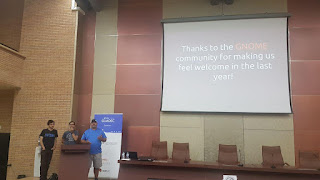I recently attended GUADEC 2019 in Thessaloniki, Greece. This is the seventh GUADEC I've attended, which came as a bit of a surprise when I added it up! It was great to catch up in person (some again, and some new!) and as always the face to face communication makes future online interactions that much easier.
This year we had seven people from Canonical Ubuntu desktop team in attendance. Many other companies and projects had representatives (including Collabora, Elementary OS, Endless, Igalia, Purism, RedHat, SUSE and System76). I think this was the most positive GUADEC I've attended, with people from all these organizations actively leading discussions and a general consideration of each other as we try and maximise where we can collaborate.
Of course, the community is much bigger than a group of companies. In particular is was great to meet Carlo and Frederik from the Yaru theme project. They've been doing amazing work on a new theme for Ubuntu and it will be great to see it land in a future release.
In the annual report there was a nice surprise; I made the most merge requests this year! I think this is a reflection on the step change in productivity in GNOME since switching to GitLab. So now I have a challenge to maintain that for next year...
If you were unable to attend you can watch the all talks on YouTube. Two talks I'd like to highlight; the first one is by Britt Yazel from the Engagement team. In it he talks about Setting a Positive Voice for GNOME. He talked about how open source communities have a lot of passion - and that has good and bad points. The Internet being as it is can lead to the trolls taking over but we can counter that but highlighting positive messages and showing the people behind GNOME. One of the examples showed how Ubuntu and GNOME have been posting positive messages on their channels about each-other, which is great!
The second talk was by Georges Basile Stavracas Neto and he talked About Maintainers and Contributors. In it he talked about the difficulties of being a maintainer and the impacts of negative feedback. It resonated with Britt's talk in that we need to highlight that maintainers are people who are doing their best! As state in the GNOME Code of Conduct - Assume people mean well (they really do!).
Georges and I are co-maintainers of Settings and we had a productive GUADEC and managed to go through and review all the open merge requests.
There were a number of discussions around Snaps in GNOME. There seemed a lot more interest in Snap technology compared to last GUADEC and it was great to be able to help people better understand them. Work included discussions about portals, better methods of getting the Freedesktop and GNOME stacks snapped, Snap integration in Settings and the GNOME publisher name in the Snap Store.
I hope to be back next year!
 |
| Photo by Cassidy James Blaede |
This year we had seven people from Canonical Ubuntu desktop team in attendance. Many other companies and projects had representatives (including Collabora, Elementary OS, Endless, Igalia, Purism, RedHat, SUSE and System76). I think this was the most positive GUADEC I've attended, with people from all these organizations actively leading discussions and a general consideration of each other as we try and maximise where we can collaborate.
Of course, the community is much bigger than a group of companies. In particular is was great to meet Carlo and Frederik from the Yaru theme project. They've been doing amazing work on a new theme for Ubuntu and it will be great to see it land in a future release.
In the annual report there was a nice surprise; I made the most merge requests this year! I think this is a reflection on the step change in productivity in GNOME since switching to GitLab. So now I have a challenge to maintain that for next year...
If you were unable to attend you can watch the all talks on YouTube. Two talks I'd like to highlight; the first one is by Britt Yazel from the Engagement team. In it he talks about Setting a Positive Voice for GNOME. He talked about how open source communities have a lot of passion - and that has good and bad points. The Internet being as it is can lead to the trolls taking over but we can counter that but highlighting positive messages and showing the people behind GNOME. One of the examples showed how Ubuntu and GNOME have been posting positive messages on their channels about each-other, which is great!
The second talk was by Georges Basile Stavracas Neto and he talked About Maintainers and Contributors. In it he talked about the difficulties of being a maintainer and the impacts of negative feedback. It resonated with Britt's talk in that we need to highlight that maintainers are people who are doing their best! As state in the GNOME Code of Conduct - Assume people mean well (they really do!).
Georges and I are co-maintainers of Settings and we had a productive GUADEC and managed to go through and review all the open merge requests.
There were a number of discussions around Snaps in GNOME. There seemed a lot more interest in Snap technology compared to last GUADEC and it was great to be able to help people better understand them. Work included discussions about portals, better methods of getting the Freedesktop and GNOME stacks snapped, Snap integration in Settings and the GNOME publisher name in the Snap Store.
I hope to be back next year!

















